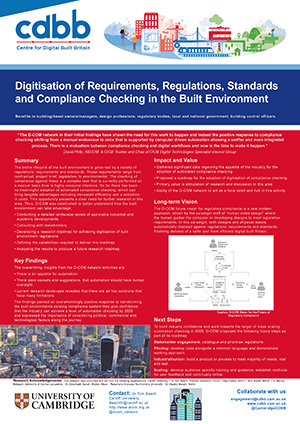Digitisation of Requirements, Regulations and Compliance Checking Processes in the Built Environment. The D-COM network has been formed to drive forward the adoption of the digitization of regulations, requirements and compliance checking systems in the built environment.
Dr Tom Beach, Cardiff University
'D-COM: Digitisation of Requirements, Regulations and Compliance Checking Processes in the Built Environment
 [FINAL REPORT] - https://doi.org/10.17863/CAM.40451
[FINAL REPORT] - https://doi.org/10.17863/CAM.40451
This is a critical topic because, the entire lifecycle of the built environment is governed by a variety of regulations and requirements. These range from contractual requirements, requirements specified in the project brief, legislative requirements, and self-imposed environmental performance requirements. The checking of compliance against these requirements is a complex task, that is currently performed on a manual basis, thus is highly resource intensive.
So far there has been no meaningful adoption of either the digitisation of regulations/requirements or compliance systems. This is because datasets created during planning stages (i.e. BIM models) were not sufficiently mature. Thus, the state of the art in the field includes limited software vendor adoption of compliance checking together with scattered development of ad-hoc approaches for monitoring/achieving compliance across varying stages of the construction life-cycle. These ad-hoc solutions lack scalability (ability to scale from small to larger buildings or to district/city levels), transferability (ability to be altered to support different requirements, or to translate from one project to another) or accessibility (often requiring significant scientific/technical expertise to implement). Moreover, large areas of this problem space remain sparsely researched, including; the concept of a living brief with requirements spanning the entire lifecycle of the asset, technologies to enable the site based monitoring of compliance and monitoring of compliance of assets in the operation phase of their lifecycle (i.e. after commissioning/handover).
The increasing maturity of information models and adoption of BIM means compliance checking is becoming feasible. This opportunity presents a clear need for further research in the areas of; (a) digitizing and subsequently managing requirements and regulations drawn from a variety of contexts and sources, (b) automatic and semi-automatic compliance systems, (c) underpinning data formats to store and subsequently analyse the result of regulatory compliance checking, (d) use cases for compliance data at a district/city/national scale, (e) convergence of private and public requirement specification for automated design.
The D-COM Network will bring together academic and industrial participants to being work in satisfying this need by; (a) assessing the current state of the art in the area, (b) gathering requirements from stakeholders, (c) defining, together with industrial and policy making stakeholders, the future pathways for development, (d) defining the capabilities and research required to deliver the defined pathways and (e) build a community that can conduct this research and develop capabilities.
For more information, and to keep up to date with the D-COM Network, please contact Dr Tom Beach.

